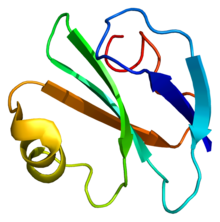CD59

La glycoprotéine CD59, également connue sous le nom de "MAC-Inhibitory Protein" (MAC-IP) ou "membrane inhibitor of reactive lysis" (MIRL), ou de protectine, est une protéine présente chez l'homme, codée par le gène CD59[1]. Elle appartient à la famille de protéines LY6/uPAR/alpha-neurotoxine[2].
La protéine, ou cluster de différenciation CD59 est attachée aux cellules hôtes par l'intermédiaire de glycophosphatidylinositol (GPI) d'ancrage. Lorsque l'activation du complément conduit à un dépôt de C5b678 sur les cellules hôtes, CD59 peut empêcher C9 de polymériser et former le complexe d'attaque de membrane du complément[3]. Elle peut également signaler à la cellule d'effectuer des mesures actives telles que l'endocytose du complexe CD59-CD9[2] .
Les mutations affectant GPI qui réduisent l'expression de CD59 et du facteur accélérant le déclin sur les globules rouges induisent une hémoglobinurie paroxystique nocturne[4].
Les virus tels que le VIH, cytomégalovirus humain et la vaccine intègrent CD59 dans leur propre enveloppe virale pour éviter la lyse par le système du complément[5].
Notes et références
[modifier | modifier le code]- « Entrez Gene: CD59 molecule, complement regulatory protein »
- M. Maio, L. I. Brasoveanu, S. Coral, L. Sigalotti, E. Lamaj, A. Gasparollo, A. Visintin, M. Altomonte et E. Fonsatti, « Structure, distribution, and functional role of protectin (CD59) in complement-susceptibility and in immunotherapy of human malignancies (Review) », international journal of oncology, vol. 13, no 2, , p. 305–18 (PMID 9664126, DOI 10.3892/ijo.13.2.305)
- Y. Huang, F. Qiao, R. Abagyan, S. Hazard et S. Tomlinson, « Defining the CD59-C9 binding interaction », J. Biol. Chem., vol. 281, no 37, , p. 27398–27404 (PMID 16844690, DOI 10.1074/jbc.M603690200)
- C. Parker, M. Omine, S. Richards et al., « Diagnosis and management of paroxysmal nocturnal hemoglobinuria », Blood, vol. 106, no 12, , p. 3699–709 (PMID 16051736, PMCID 1895106, DOI 10.1182/blood-2005-04-1717, lire en ligne)
- O. Bohana-Kashtan, L. Ziporen, N. Donin, S. Kraus et Z. Fishelson, « Cell signals transduced by complement », Mol. Immunol., vol. 41, nos 6–7, , p. 583–597 (PMID 15219997, DOI 10.1016/j.molimm.2004.04.007)
Liens externes
[modifier | modifier le code]- (en) MeSH CD59+Antigen
Text is available under the CC BY-SA 4.0 license; additional terms may apply.
Images, videos and audio are available under their respective licenses.
